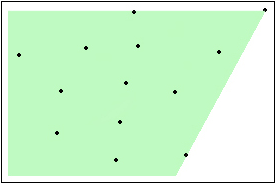LightOJ 1203--Guarding Bananas(二维凸包+内角计算)
| Time Limit: 3 second(s) | Memory Limit: 32 MB |
Once there was a lazy monkey in a forest. But he loved banana too much. One day there was a storm in the jungle and all the bananas fell from the trees. The monkey didn't want to lose any of the bananas. So, he wanted to find a banana such that he can eat that and he can also look after the other bananas. As he was lazy, he didn't want to move his eyes too wide. So, you have to help him finding the banana from where he can look after all the bananas but the degree of rotating his eyes is as small as possible. You can assume that the position of the bananas can be modeled as 2D points.

Here a banana is shown, from where the monkey can look after all the bananas with minimum eye rotation.
Input
Input starts with an integer T (≤ 13), denoting the number of test cases.
Each case starts with a line containing an integer n (1 ≤ n ≤ 105) denoting the number of bananas. Each of the next n lines contains two integers x y (-109 ≤ x, y ≤ 109) denoting the co-ordinate of a banana. There can me more than one bananas in the same co-ordinate.
Output
For each case, print the case number and the minimum angle in degrees. Errors less than 10-6 will be ignored.
Sample Input |
Output for Sample Input |
|
2 1 4 4 4 0 0 10 0 10 10 2 1 |
Case 1: 0 Case 2: 45.0000000 |
Note
Dataset is huge. Use faster I/O methods.
- 题意:在所有给定的香蕉中找到一个香蕉,使得从这个香蕉看向其他香蕉的角度尽可能小的同时看到的香蕉数目尽可能多。
- 由于香蕉可以化为半径忽略不计的二维平面上的点,所以可以想到,站在这些点的凸包的顶点处看过去的角度小并且看到的点更多,否则,总可以向这些定顶点处移动,使得看到的点更多或者角度更小。
- 所以这道题就是求其凸包,然后找到里面最小的那个内角。
#include<iostream>
#include<algorithm>
#include<cmath>
#include<cstdio>
#include<cstring>
using namespace std;
const int maxn = 1e5 + ;
const double pi = acos(-1.0);
const double eps = 1e-;
int sgn(double x) {
if (fabs(x) < eps)return ;
if (x < )return -;
else return ;
}
typedef struct point {
double x, y;
point() { }
point(double a, double b) {
x = a;
y = b;
}
point operator -(const point &b) const {
return point(x - b.x, y - b.y);
}
double operator *(const point &b)const {
return x*b.x + y*b.y;
}
double operator ^(const point &b)const { //叉乘
return x*b.y - y*b.x;
}
bool operator <(point b)const {
return sgn(x - b.x) == ? sgn(y - b.y)< : x<b.x;
}
//返回pa,pb的夹角,该点看a,b的夹角,弧度制
//弧度=度×π/180°
//度=弧度×180°/π
double rad(point a, point b) {
point p = *this;
return fabs(atan2(fabs((a - p) ^ (b - p)), (a - p)*(b - p)));
}
}point;
point p[maxn];
int n = , res[maxn];
int top;//top模拟栈顶
bool multi(point p1, point p2, point p0) { //判断p1p0和p2p0的关系,<0,p1p0在p2p0的逆时针方向,>0,p1p0在p2p0的顺时针方向
return (p1.x - p0.x)*(p2.y - p0.y) >= (p2.x - p0.x)*(p1.y - p0.y);
}
double Graham() {
int i, len;//top模拟栈顶
sort(p, p + n);
top = ;
//少于3个点也就没有办法形成凸包
if (n == )return ; res[] = ;
if (n == )return ; res[] = ;
if (n == )return ; res[] = ;
for (i = ; i < n; i++) {
while (top&&multi(p[i], p[res[top]], p[res[top - ]])) //如果当前这个点和栈顶两个点构成折线右拐了,就回溯到上一个点
top--; //弹出栈顶
res[++top] = i; //否则将这个点入栈
}
len = top;
res[++top] = n - ;
for (i = n - ; i >= ; i--) {
while (top != len&&multi(p[i], p[res[top]], p[res[top - ]]))
top--;
res[++top] = i;
}
double ans =0x3f3f3f;
res[top] = res[],res[top + ] = res[];
for (int i = ; i <= top; i++) {
ans = min(ans, p[res[i]].rad(p[res[i + ]], p[res[i - ]]));
}
return ans / pi * ;
}
inline int read()
{
int x = , f = ; char ch = getchar();
while (ch<'' || ch>'') { if (ch == '-')f = -; ch = getchar(); }
while (ch >= ''&&ch <= '') { x = x * + ch - ''; ch = getchar(); }
return x*f;
}
int main(void) {
int t;
t = read();
for (int cnt = ; cnt <= t; cnt++) {
cin >> n;
for (int i = ; i < n; i++) {
p[i].x = read();
p[i].y = read();
}
printf("Case %d: ", cnt);
printf("%.7lf\n", Graham());
}
return ;
}
LightOJ 1203--Guarding Bananas(二维凸包+内角计算)的更多相关文章
- LightOJ 1203 Guarding Bananas (凸包最小顶角)
题目链接:LightOJ 1203 Problem Description Once there was a lazy monkey in a forest. But he loved banana ...
- 计算几何 二维凸包问题 Andrew算法
凸包:把给定点包围在内部的.面积最小的凸多边形. Andrew算法是Graham算法的变种,速度更快稳定性也更好. 首先把全部点排序.依照第一keywordx第二keywordy从小到大排序,删除反复 ...
- 使用Graham扫描法求二维凸包的一个程序
#include <iostream> #include <cstring> #include <cstdlib> #include <cmath> # ...
- luogu P2742 【模板】二维凸包 / [USACO5.1]圈奶牛Fencing the Cows
题解: 二维凸包裸题 按照x坐标为第一关键字,y坐标为第二关键字排序 然后相邻判断叉积用单调队列搞过去 正反都做一次就好了 代码: #include <bits/stdc++.h> usi ...
- Luogu P2742 模板-二维凸包
Luogu P2742 模板-二维凸包 之前写的实在是太蠢了.于是重新写了一个. 用 \(Graham\) 算法求凸包. 注意两个向量 \(a\times b>0\) 的意义是 \(b\) 在 ...
- 【洛谷 P2742】【模板】二维凸包
题目链接 二维凸包板子..有时间会补总结的. #include <cstdio> #include <cmath> #include <algorithm> usi ...
- poj 2079 Triangle (二维凸包旋转卡壳)
Triangle Time Limit: 3000MS Memory Limit: 30000KB 64bit IO Format: %I64d & %I64u Submit Stat ...
- poj 2187 Beauty Contest(二维凸包旋转卡壳)
D - Beauty Contest Time Limit:3000MS Memory Limit:65536KB 64bit IO Format:%I64d & %I64u ...
- UVA 10652 Board Wrapping(二维凸包)
传送门 刘汝佳<算法竞赛入门经典>P272例题6包装木板 题意:有n块矩形木板,你的任务是用一个面积尽量小的凸多边形把它们抱起来,并计算出木板占整个包装面积的百分比. 输入:t组数据,每组 ...
随机推荐
- Linux基础之-利用shell脚本实现自动监控系统服务
目的:监控集群内nginx及nfs服务运行是否正常,如任一服务异常,则发送邮件通知用户 条件: 1. 主机及子机IP地址,hostname已确定: 2. 主机与子机能够免密通讯,即基于密匙通讯(相关命 ...
- Qt判断鼠标在控件上
QT判断鼠标是否在某子窗口控件上方 需要注意的是,子窗口获取geometry,是相对于父窗口的相对位置,QCursor::pos()获取的是鼠标绝对位置,要不将父窗口的相对位置进行换算,要不将鼠标的绝 ...
- PHP 使用WampServer环境,如何配置虚拟主机域名
很多人不会配置虚拟主机,我这里简单交一下大家,分三步: 1.在 C:\Windows\System32\drivers\etc 文件夹中的文件 Hosts 文件修改代码为: 127.0.0.1 loc ...
- freess(未测试)
freess 使用 nodejs 配合 shadowsocks-windows 实现FQ (windows) 使用方法: 如果你没有安装nodejs请先安装,访问 https://nodejs.org ...
- Tomcat你很少使用的安全管理SecurityManager
试想一下,如果你的JSP页面中包含一句代码“System.exit(1);”,你的web应用访问到该JSP时,会发生什么? 一般使用tomcat可能都没有注意到这个问题,本篇主要讲述tomcat 6中 ...
- February 22 2017 Week 8 Wednesday
There is only one happiness in life, to love and be loved. 生命中只有一种幸福,爱与被爱. If you think you are not ...
- 事件总线(Event Bus)
事件总线(Event Bus)知多少 源码路径:Github-EventBus简书同步链接 1. 引言 事件总线这个概念对你来说可能很陌生,但提到观察者(发布-订阅)模式,你也许就很熟悉.事件总线是对 ...
- angularJS报错$apply already in progress的原因和解决方法
如果我们使用了AngularJS中的$scope.$apply()或者$scope.$digest(),我们很可能会遇到类似下面的错误,虽然这个错误没有太大影响,但是在日志中看起来还是很不爽的,日志中 ...
- 折腾apt源的时候发生的错误
在折腾Ubuntu源的时候,把新的源替换进去,然后 sudo apt-get update 之后报错: W: Unknown Multi-Arch type 'no' for package 'com ...
- 优秀的WEB前端开发框架:Bootstrap!
其实早就对Bootstrap有所耳闻,大概了解这哥们是做WEB前端的 但直到昨天以前,还没有对他产生任何深入了解的兴趣 冷落他的主要原因还是觉得会束缚手脚,毕竟自己多年来在WEB前端的积累一直没有停滞 ...
